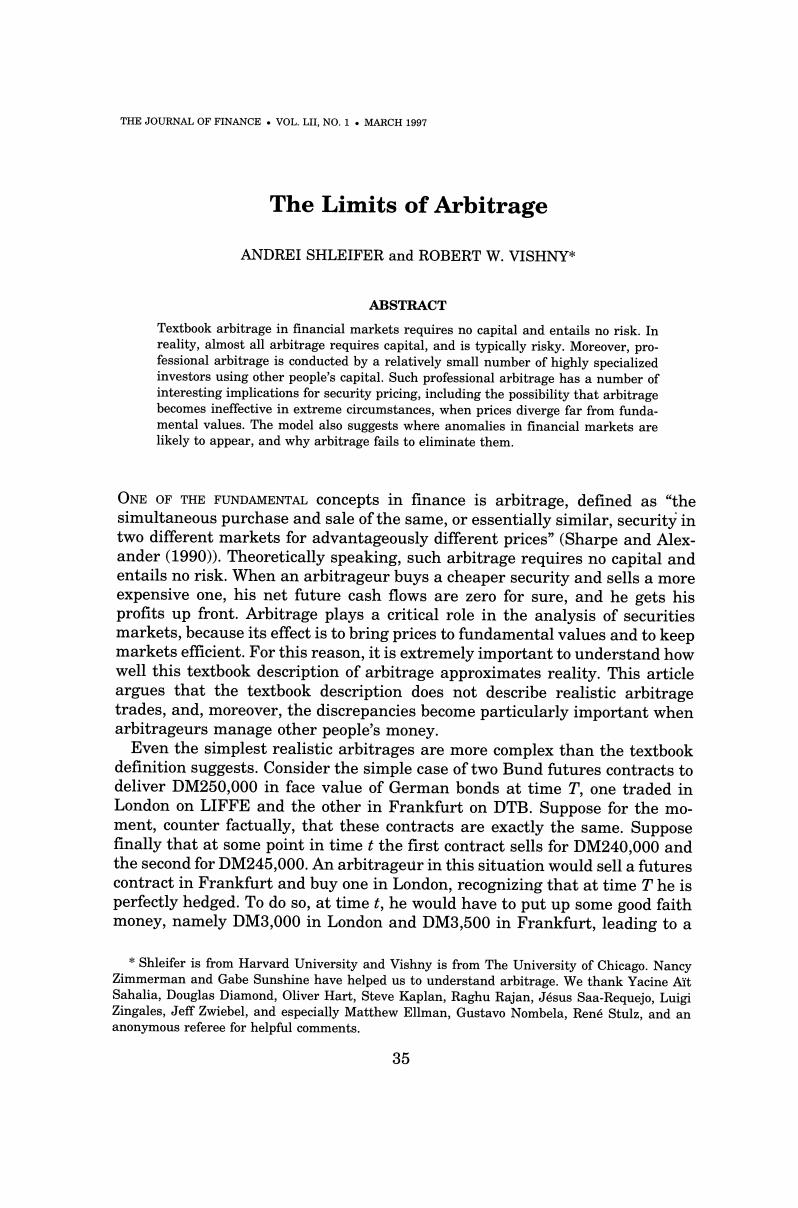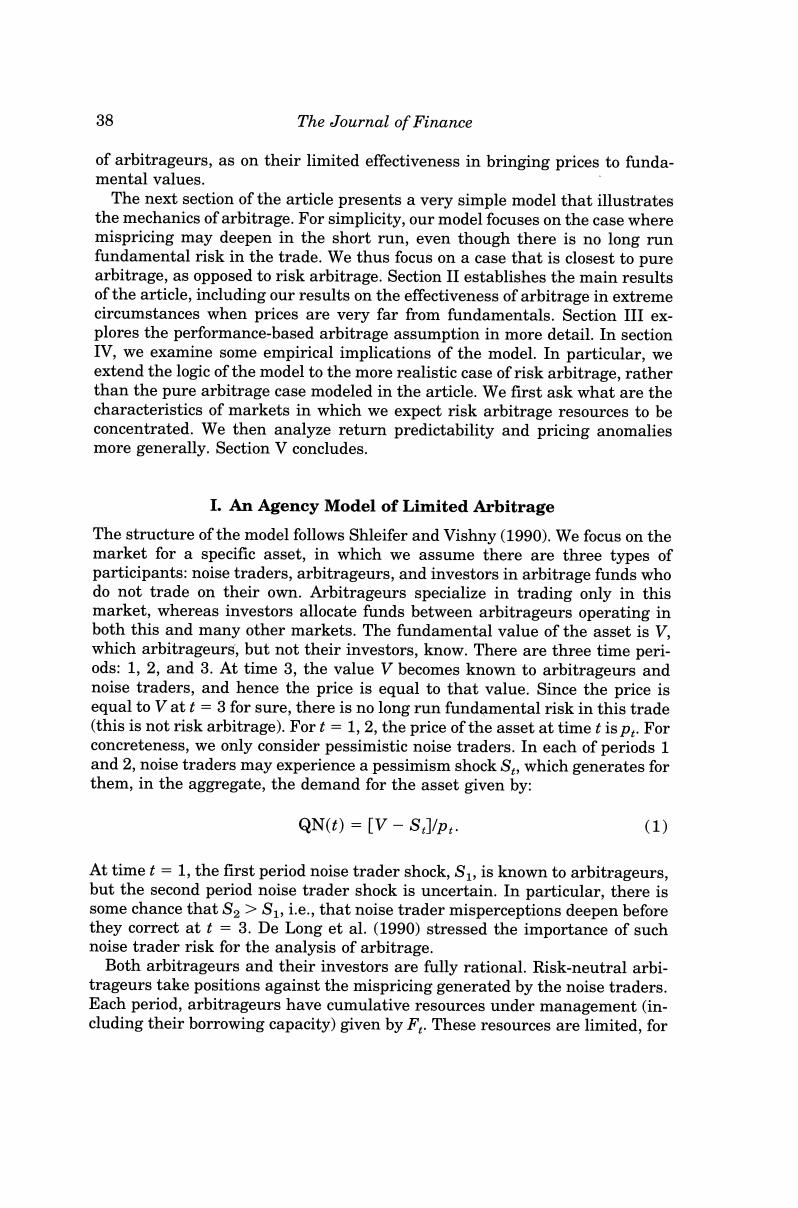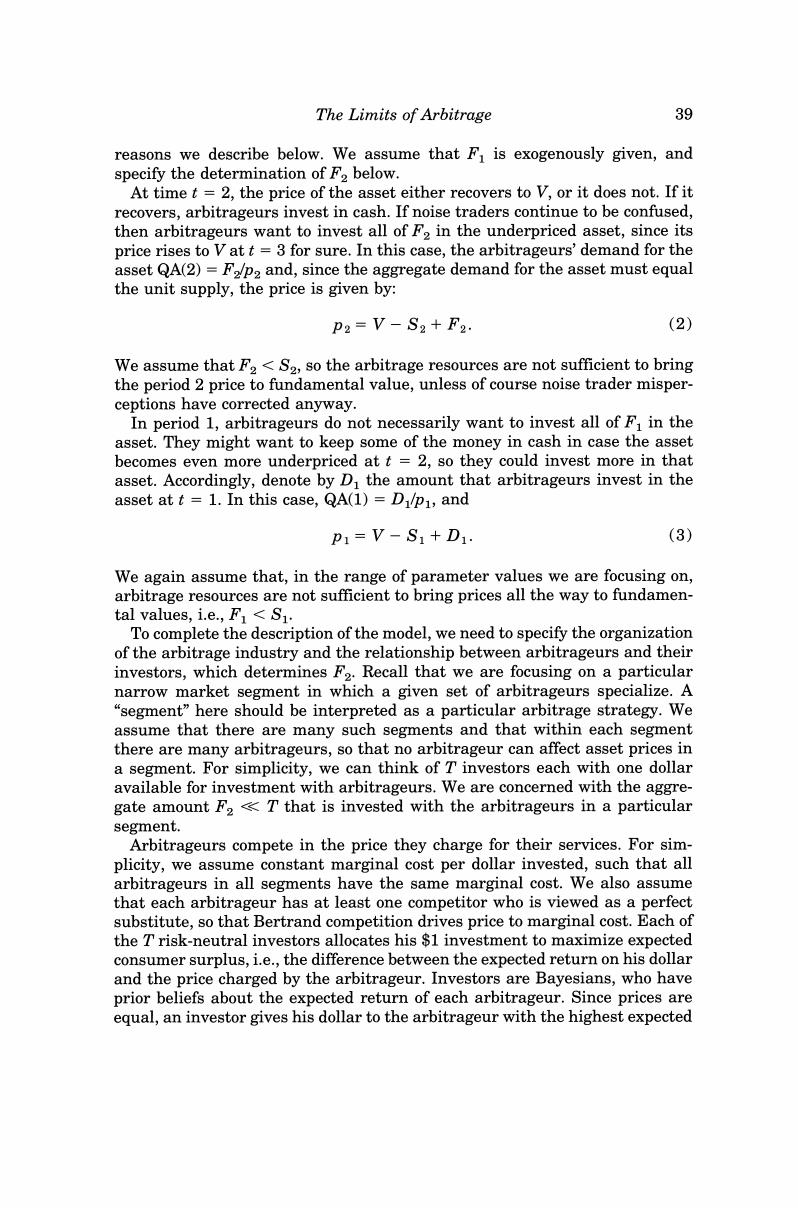
THE JOURNAL OF FINANCE.VOL.LII,NO.1.MARCH 1997 The Limits of Arbitrage ANDREI SHLEIFER and ROBERT W.VISHNY* ABSTRACT Textbook arbitrage in financial markets requires no capital and entails no risk.In reality,almost all arbitrage requires capital,and is typically risky.Moreover,pro- fessional arbitrage is conducted by a relatively small number of highly specialized investors using other people's capital.Such professional arbitrage has a number of interesting implications for security pricing,including the possibility that arbitrage becomes ineffective in extreme circumstances,when prices diverge far from funda- mental values.The model also suggests where anomalies in financial markets are likely to appear,and why arbitrage fails to eliminate them. ONE OF THE FUNDAMENTAL concepts in finance is arbitrage,defined as "the simultaneous purchase and sale of the same,or essentially similar,security in two different markets for advantageously different prices"(Sharpe and Alex- ander(1990)).Theoretically speaking,such arbitrage requires no capital and entails no risk.When an arbitrageur buys a cheaper security and sells a more expensive one,his net future cash flows are zero for sure,and he gets his profits up front.Arbitrage plays a critical role in the analysis of securities markets,because its effect is to bring prices to fundamental values and to keep markets efficient.For this reason,it is extremely important to understand how well this textbook description of arbitrage approximates reality.This article argues that the textbook description does not describe realistic arbitrage trades,and,moreover,the discrepancies become particularly important when arbitrageurs manage other people's money. Even the simplest realistic arbitrages are more complex than the textbook definition suggests.Consider the simple case of two Bund futures contracts to deliver DM250,000 in face value of German bonds at time T,one traded in London on LIFFE and the other in Frankfurt on DTB.Suppose for the mo- ment,counter factually,that these contracts are exactly the same.Suppose finally that at some point in time t the first contract sells for DM240,000 and the second for DM245,000.An arbitrageur in this situation would sell a futures contract in Frankfurt and buy one in London,recognizing that at time T he is perfectly hedged.To do so,at time t,he would have to put up some good faith money,namely DM3,000 in London and DM3,500 in Frankfurt,leading to a Shleifer is from Harvard University and Vishny is from The University of Chicago.Nancy Zimmerman and Gabe Sunshine have helped us to understand arbitrage.We thank Yacine Ait Sahalia,Douglas Diamond,Oliver Hart,Steve Kaplan,Raghu Rajan,Jesus Saa-Requejo,Luigi Zingales,Jeff Zwiebel,and especially Matthew Ellman,Gustavo Nombela,Rene Stulz,and an anonymous referee for helpful comments. 35

36 The Journal of Finance net cash outflow of DM6,500.However,he does not get the DM5,000 difference in contract prices at the time he puts on the trade.Suppose that prices of the two contracts both converge to DM242,500 just after t,as the market returns to efficiency.In this case,the arbitrageur would immediately collect DM2,500 from each exchange,which would simultaneously charge the counter parties for their losses.The arbitrageur can then close out his position and get back his good faith money as well.In this near textbook case,the arbitrageur required only DM6,500 of capital and collected his profits at some point in time between t and T. Even in this simplest example,the arbitrageur need not be so lucky.Suppose that soon after t,the price of the futures contract in Frankfurt rises to DM250,000,thus moving further away from the price in London,which stays at DM240,000.At this point,the Frankfurt exchange must charge the arbi- trageur DM5,000 to pay to his counter party.Even if eventually the prices of the two contracts converge and the arbitrageur makes money,in the short run he loses money and needs more capital.The model of capital-free arbitrage simply does not apply.If the arbitrageur has deep enough pockets to always access this capital,he still makes money with probability one.But if he does not,he may run out of money and have to liquidate his position at a loss. In reality,the situation is more complicated since the two Bund contracts have somewhat different trading hours,settlement dates,and delivery terms. It may easily happen that the arbitrageur has to find the money to buy bonds so that he can deliver them in Frankfurt at time T.Moreover,if prices are moving rapidly,the value of bonds he delivers and the value of bonds delivered to him may differ,exposing the arbitrageur to additional risks of losses.Even this simplest trade then becomes a case of what is known as risk arbitrage.In risk arbitrage,an arbitrageur does not make money with probability one,and may need substantial amounts of capital to both execute his trades and cover his losses.Most real world arbitrage trades in bond and equity markets are examples of risk arbitrage in this sense.Unlike in the textbook model,such arbitrage is risky and requires capital. One way around these concerns is to imagine a market with a very large number of tiny arbitrageurs,each taking an infinitesimal position against the mispricing in a variety of markets.Because their positions are so small,capital constraints are not binding and arbitrageurs are effectively risk neutral to- ward each trade.Their collective actions,however,drive prices toward funda- mental values.This,essentially,is the model of arbitrage implicit in Fama's (1965)classic analysis of efficient markets and in models such as CAPM (Sharpe(1964))and APT (Ross(1976)). The trouble with this approach is that the millions of little traders are typically not the ones who have the knowledge and information to engage in arbitrage.More commonly,arbitrage is conducted by relatively few profes- sional,highly specialized investors who combine their knowledge with re- sources of outside investors to take large positions.The fundamental feature of such arbitrage is that brains and resources are separated by an agency rela- tionship.The money comes from wealthy individuals,banks,endowments,and

The Limits of Arbitrage 37 other investors with only a limited knowledge of individual markets,and is invested by arbitrageurs with highly specialized knowledge of these markets. In this article,we examine such arbitrage and its effectiveness in achieving market efficiency. In particular,the implications of the fact that arbitrage-whether it is ultimately risk-free or risky-generally requires capital become extremely important in the agency context.In models without agency problems,arbitra- geurs are generally more aggressive when prices move further from funda- mental values (see Grossman and Miller(1988),De Long et al.(1990),Camp- bell and Kyle(1993)).In our Bund example above,an arbitrageur would in general increase his positions if London and Frankfurt contract prices move further out of line,as long as he has the capital.When the arbitrageur manages other people's money,however,and these people do not know or understand exactly what he is doing,they will only observe him losing money when futures prices in London and Frankfurt diverge.They may therefore infer from this loss that the arbitrageur is not as competent as they previously thought,refuse to provide him with more capital,and even withdraw some of the capital-even though the expected return from the trade has increased. We refer to the phenomenon of responsiveness of funds under management to past returns as performance based arbitrage.Unlike arbitrageurs using their own money,who allocate funds based on expected returns from trades, investors may rationally allocate money based on past returns of arbitrageurs. When arbitrage requires capital,arbitrageurs can become most constrained when they have the best opportunities,i.e.,when the mispricing they have bet against gets even worse.Moreover,the fear of this scenario would make them more cautious when they put on their initial trades,and hence less effective in bringing about market efficiency.This article argues that this feature of arbitrage can significantly limit its effectiveness in achieving market effi- ciency. We show that performance-based arbitrage is particularly ineffective in extreme circumstances,where prices are significantly out of line and arbitra- geurs are fully invested.In these circumstances,arbitrageurs might bail out of the market when their participation is most needed.Performance based arbi- trage,then,is even more limited than arbitrage described in earlier models of inefficient markets,such as Grossman and Miller(1988),De Long et al.(1990), and Campbell and Kyle (1993). Ours is obviously not the first study of the consequences of delegated port- folio management.Early articles in this area include Allen(1990)and Bhat- tacharya-Pfleiderer (1985).Scharfstein and Stein (1990)model herding by money managers operating on incentive contracts.Lakonishok,Shleifer,Tha- ler,and Vishny(1991)and Chevalier and Ellison(1995)consider the possibil- ity that money managers "window dress"their portfolios to impress investors. In two interesting recent articles,Allen and Gorton (1993)and Dow and Gorton(1994)show how money managers can churn assets to mislead their investors,and how such churning can sustain inefficient asset prices.Unlike this work,our article does not focus as much on the distortions in the behavior

38 The Journal of Finance of arbitrageurs,as on their limited effectiveness in bringing prices to funda- mental values. The next section of the article presents a very simple model that illustrates the mechanics of arbitrage.For simplicity,our model focuses on the case where mispricing may deepen in the short run,even though there is no long run fundamental risk in the trade.We thus focus on a case that is closest to pure arbitrage,as opposed to risk arbitrage.Section II establishes the main results of the article,including our results on the effectiveness of arbitrage in extreme circumstances when prices are very far from fundamentals.Section III ex- plores the performance-based arbitrage assumption in more detail.In section IV,we examine some empirical implications of the model.In particular,we extend the logic of the model to the more realistic case of risk arbitrage,rather than the pure arbitrage case modeled in the article.We first ask what are the characteristics of markets in which we expect risk arbitrage resources to be concentrated.We then analyze return predictability and pricing anomalies more generally.Section V concludes. I.An Agency Model of Limited Arbitrage The structure of the model follows Shleifer and Vishny(1990).We focus on the market for a specific asset,in which we assume there are three types of participants:noise traders,arbitrageurs,and investors in arbitrage funds who do not trade on their own.Arbitrageurs specialize in trading only in this market,whereas investors allocate funds between arbitrageurs operating in both this and many other markets.The fundamental value of the asset is V, which arbitrageurs,but not their investors,know.There are three time peri- ods:1,2,and 3.At time 3,the value V becomes known to arbitrageurs and noise traders,and hence the price is equal to that value.Since the price is equal to V at t=3 for sure,there is no long run fundamental risk in this trade (this is not risk arbitrage).For t=1,2,the price of the asset at time t is p:.For concreteness,we only consider pessimistic noise traders.In each of periods 1 and 2,noise traders may experience a pessimism shock S,which generates for them,in the aggregate,the demand for the asset given by: QN(t)=[V-SJ/p:. (1) At time t 1,the first period noise trader shock,S,is known to arbitrageurs, but the second period noise trader shock is uncertain.In particular,there is some chance that S2>S1,i.e.,that noise trader misperceptions deepen before they correct at t 3.De Long et al.(1990)stressed the importance of such noise trader risk for the analysis of arbitrage. Both arbitrageurs and their investors are fully rational.Risk-neutral arbi- trageurs take positions against the mispricing generated by the noise traders. Each period,arbitrageurs have cumulative resources under management (in- cluding their borrowing capacity)given by F.These resources are limited,for

The Limits of Arbitrage 39 reasons we describe below.We assume that F is exogenously given,and specify the determination of F2 below. At time t =2,the price of the asset either recovers to V,or it does not.If it recovers,arbitrageurs invest in cash.If noise traders continue to be confused, then arbitrageurs want to invest all of F2 in the underpriced asset,since its price rises to V at t=3 for sure.In this case,the arbitrageurs'demand for the asset QA(2)=F2/p2 and,since the aggregate demand for the asset must equal the unit supply,the price is given by: p2=V-S2+F2. (2) We assume that F2<S2,so the arbitrage resources are not sufficient to bring the period 2 price to fundamental value,unless of course noise trader misper- ceptions have corrected anyway. In period 1,arbitrageurs do not necessarily want to invest all of F in the asset.They might want to keep some of the money in cash in case the asset becomes even more underpriced at t =2,so they could invest more in that asset.Accordingly,denote by D the amount that arbitrageurs invest in the asset at t =1.In this case,QA(1)=D/p1,and p1=V-S1+D1. (3) We again assume that,in the range of parameter values we are focusing on, arbitrage resources are not sufficient to bring prices all the way to fundamen- tal values,i.e.,F<S. To complete the description of the model,we need to specify the organization of the arbitrage industry and the relationship between arbitrageurs and their investors,which determines F2.Recall that we are focusing on a particular narrow market segment in which a given set of arbitrageurs specialize.A "segment"here should be interpreted as a particular arbitrage strategy.We assume that there are many such segments and that within each segment there are many arbitrageurs,so that no arbitrageur can affect asset prices in a segment.For simplicity,we can think of T investors each with one dollar available for investment with arbitrageurs.We are concerned with the aggre- gate amount F2<T that is invested with the arbitrageurs in a particular segment. Arbitrageurs compete in the price they charge for their services.For sim- plicity,we assume constant marginal cost per dollar invested,such that all arbitrageurs in all segments have the same marginal cost.We also assume that each arbitrageur has at least one competitor who is viewed as a perfect substitute,so that Bertrand competition drives price to marginal cost.Each of the T risk-neutral investors allocates his $1 investment to maximize expected consumer surplus,i.e.,the difference between the expected return on his dollar and the price charged by the arbitrageur.Investors are Bayesians,who have prior beliefs about the expected return of each arbitrageur.Since prices are equal,an investor gives his dollar to the arbitrageur with the highest expected